

![]()
T H E L I F E A N D D E A T H S T R U G G L E

MEDAL IN HONOR OF THE
NATIONAL HERO
MAJ. GEN. A N D R A N I K O Z A N I A N
Written by Gevork Nazaryan
The Turkish "army" by mid 1918, having obliterated all of Western Armenia, had overran most of Eastern Armenia, killing and raping en route, reaching the outskirts of Holy Echmiadzin. Save The Holy City! became the rallying cry of the last remnants of the Armenian nation. A volunteer militia began to enlist Armenians young and old, rich and poor, from all walks of life, from every corner of the world. Armenians from the Americas, Europe, Asia and Africa rushed to fight the final battle in this struggle of Life and Death. Many volunteers were non-Armenians, people who simply hated the Turks for what they were doing and wanted to fight for justice and uphold human life. The Genocide would be the pinnacle of one thousand years of killing. The epic battle would take place near the village of Sardarapat, only few kilometers from the Holy City. The Turkish "army" was led by the famous or rather infamous “Gallibolu” [Gallipoli] Army. The critical energy of feelings and emotions was built up within the ranks of the Armenian fighters. The electrified atmosphere that was written in the stoic faces of the defenders was later recounted by the eyewitnesses as something of having a supernatural effect to it. If the Armenians would lose the battle -- EVERYTHING -- would be lost -- no going back, in case of defeat Darkness would prevail-- there will be no Light at the end of this long dark tunnel of history. But, Providence, in the eternal Life and Death struggle, would come through for Armenians -- again at the very last moment -- when everything suggested that the Abyss was near. It is during this time that the World War I British Lord of the Admiralty - Sir Winston Churchill - who would later be distinguished as the British Prime Minister during World War II -- would for the first time in history use the word Holocaust to describe what is happening to the Armenian nation. "An ancient race has disappeared from the pages of History..." So it seemed. At the utmost critical point of survival the Armenian fighting spirit had won. The Armenians had completely smashed the "Gallibolu" army chasing the remnants all the way to Kars. From that point on, the Armenian policy of reliance on foreign, outside forces had relinquished. Self-reliance became the new policy which to a great degree is still ingrained in Armenian individual psyche and collective consciousness.

ARSEN GOERGIZIAN ONE OF THE LEADING
MEMBERS OF THE DEFENSE COMMITTEE
The ancient Armenian fortress-city of Van wrote one of the most heroic pages of resistance to the Turkish onslaught during the years of the Genocide. A large Turkish army that included the death squad units of the Special Organization was in charge of eradicating the Armenian population of the Vaspurakan province [Villayet of Van]. The Turkish army along with bands of Kurds specifically targeted women and children. Women were stripped of their possessions, raped and killed. Small children were either killed or taken in to be raised as either Turks or Kurds. Thousands of Armenian villagers fled to the safety of the Van fortress. The huge fortress of Van, located in the heart of the city, since the days of the Kingdom of Ararat, served as the gathering point for defense and resistance, against foreign invaders.
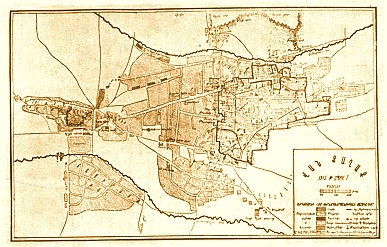
THE MAP OF THE CITY WITH THE DEFENSE POSITIONS OF THE CITIZEN
MILITIA
ISSUED BY THE AYGESTAN COMMITTEE ON APRIL 7, 1915
A Defense Committee, which became known as the Aygestan Committee was led by the prominent leaders and members of the intelligentsia of the Community. Four primary defense positions -- in the four cardinal directions -- were set up on the Eastern, Western, Northern and Southern sections of the fortress. The eastern section was under the command of Davit' Sarkisian, the western under the command of Harut'iwn Nerkarian, the northern under Mihran T'oromanian and the southern under Mihrdat Mirzaxanian. The overall command of the positions and defense was given to a gifted organizer and leader -- Haik Kosoyan -- whose leadership skills were critical in calming the situation and bringing order in a chaos and confusion of the panic-stricken and fearful villagers.

THE HEROIC DEFENSE OF VAN BY THE MUNICIPAL VOLUNTEER MILITIA
IF THE TURKISH ITTIHADIST SPECIAL ORGANIZATION EXTERMINATION
DEATH SQUADS WOULD HAVE BROKEN THROUGH
ALL THE INHABITANTS WOULD HAVE BEEN KILLED OFF...
Providing adequate rations of food and shelter to these people along with providing logistical instructions to the fighters on the walls was Commander Kosoyan's and the rest of the Committee's primary focus. The Committee's HQ were setup in Van's Prelacy building. The few hundred fighters were divided into five regiments. Four would take up positions on the fortifications while the fifth would be stationed on the inside as a rotating relief detachment. On 9:00 am April 7, 1915 the Turks under the bloody butcher Djevdet bey attacked only to be driven back by the Armenian fighters. The Turkish assaults continued unabated only to be time and again beaten back to their positions. The defenders heroically fought for weeks until reinforcements of Armenian fighters from Eastern Armenian, under the leadership of the outstanding National Hero Maj. Gen. Andranik Ozanian, with Russian Army liberated Van and the population had a chance to safely evacuate to Eastern Armenia, most notable to Yerevan and the suburbs. Eastern Armenia in general, and Yerevan in particular, served as a safe haven for the thousands of the survivors of the Genocide.
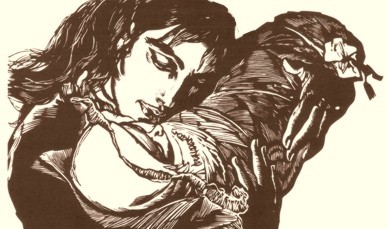
S U R V I V
O R S . . .
THE CREATIVE CIVILIZATION BUILDING
ARMENIAN PEOPLE MUST AND WILL LIVE!

HISTORIC ARMENIAN FOLK COSTUME OF A WOMAN AND A MAN OF
VASPURAKAN PROVINCE WHICH ALONG WITH AYRARAT FORMS THE HEART OF
GREATER ARMENIA. ON DISPLAY IN THE ETHNOGRAPHIC MUSEUM OF SARDARAPAT
NEXT TO THE MONUMENTAL COMPLEX MARKING THE EPIC ARMENIAN VICTORY
AT SARDARAPAT ON MAY 26, 1918 WHICH SECURED THE SALVATION OF THE
REMNANTS OF THE ARMENIAN NATION FROM COMPLETE EXTERMINATION...
THE PATTERNS ON THE COSTUME ARE HARMONICALLY ARRANGED IN
A CAREFULLY CHOSEN ARRAY OF PATTERNS, GEOMETRIC SYMBOLS AND
COLORS AS VISUAL AND SUBLIME RESONATORS OF HIGH ENERGY/LIFE.
MADE OUT OF TRADITIONALLY WOVEN WOOL AND LINEN
THE CLOTHES WERE VERY COMFORTABLE...COOL DURING SUMMER
AND WARM DURING WINTER [NOTE THE WOOL BAJKON...LIT. JACKET
ON THE MALE HIGHLANDER THAT WOULD BE WORN DURING COLDER WEATHER].
THE SYMBOLS ON THE CLOTHES GO BACK TO DAWN OF HISTORY
AND MATCH THE SAME SACROSANCT WOVEN PATTERNS ON THE WALLS
OF EARLIEST SETTLED ARMENIC COMMUNITIES CA. 9,000 BC THAT
BEGAN THE NEOLITHIC REVOLUTION IN PLACES LIKE NEVALI CORI,
CAYONU, CATAL HUYUK AND OF COURSE GOBEKLI TEPE.
ARMENIC FOLK COMMUNITY
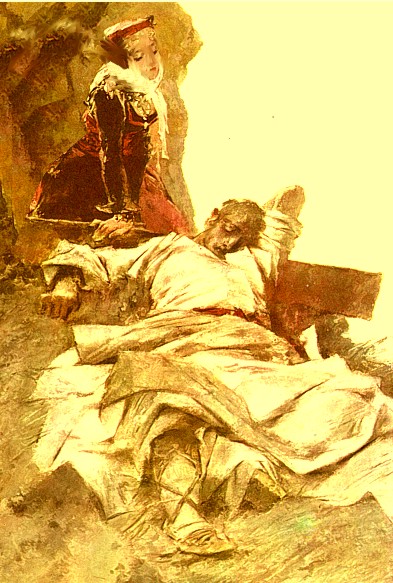
STIRRING DRAWINGS OF PRE-GENOCIDE FOLKISH LIFE
IN YERKIR BY G. KHANJIAN.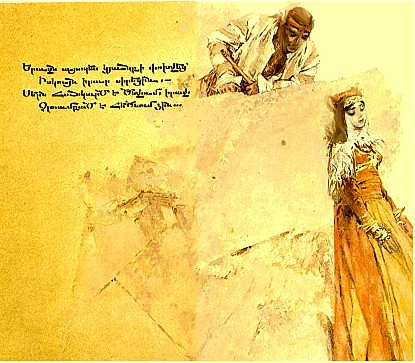
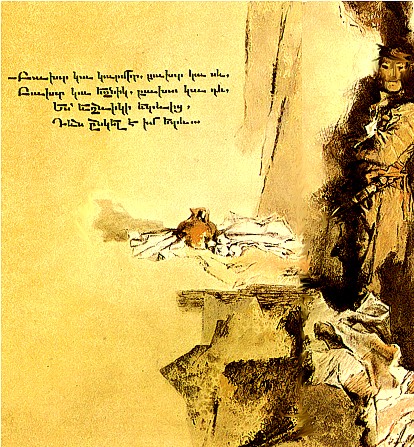
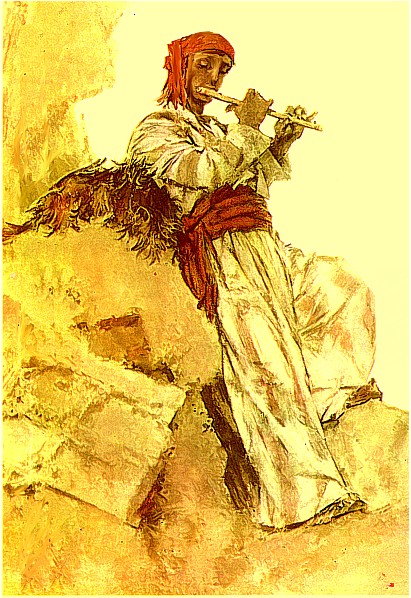
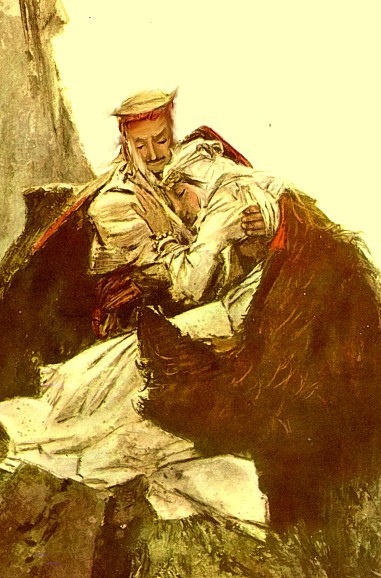
With the extermination of the native, hard-working, productive Armenian population -- for ages serving as the builders and innovators of their native soil -- Van has remained a relatively backward place. This has been as a matter of fact the faith of all of historic Armenia -- eradicated of its people, it is left virtually undeveloped by the Turkish authorities that to this day deny one of the greatest crimes in human history -- deny that millions of people once existed and made the land bloom with their sweat and hard work -- killed for wanting to be free, to live in liberty and pursue their happiness and destiny. Killed on their own native soil, by a parasitic Turkish government that lived off of their sweat and hard work that cut short uncountable lives that in the millennia long tradition of a people that created a great civilization -- builders and innovators of human progress in all its endeavors. The land is still in ruins waiting for the caretakers and the creative people to return to once again make it bloom...anew.

I M M O R T A L I T Y